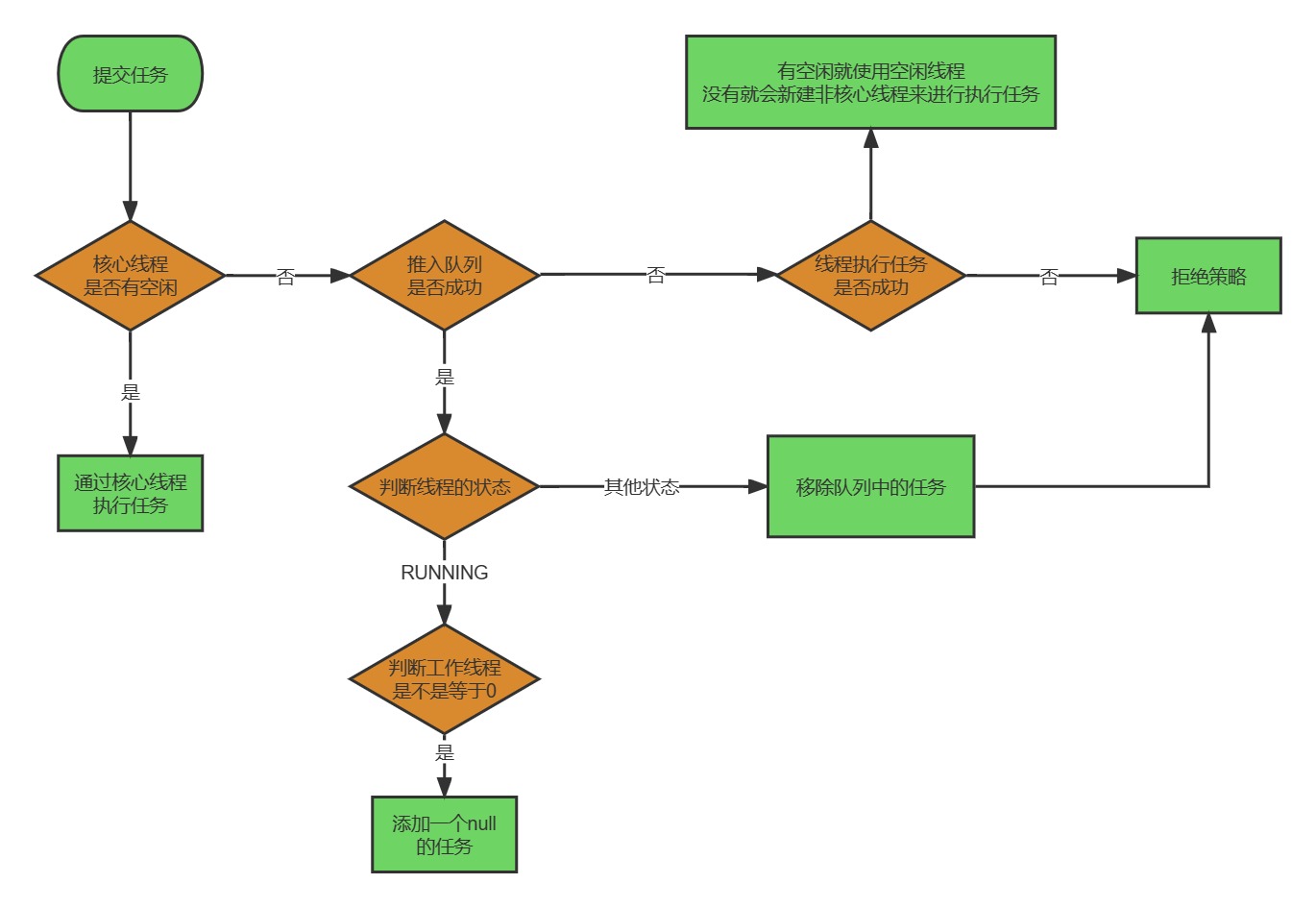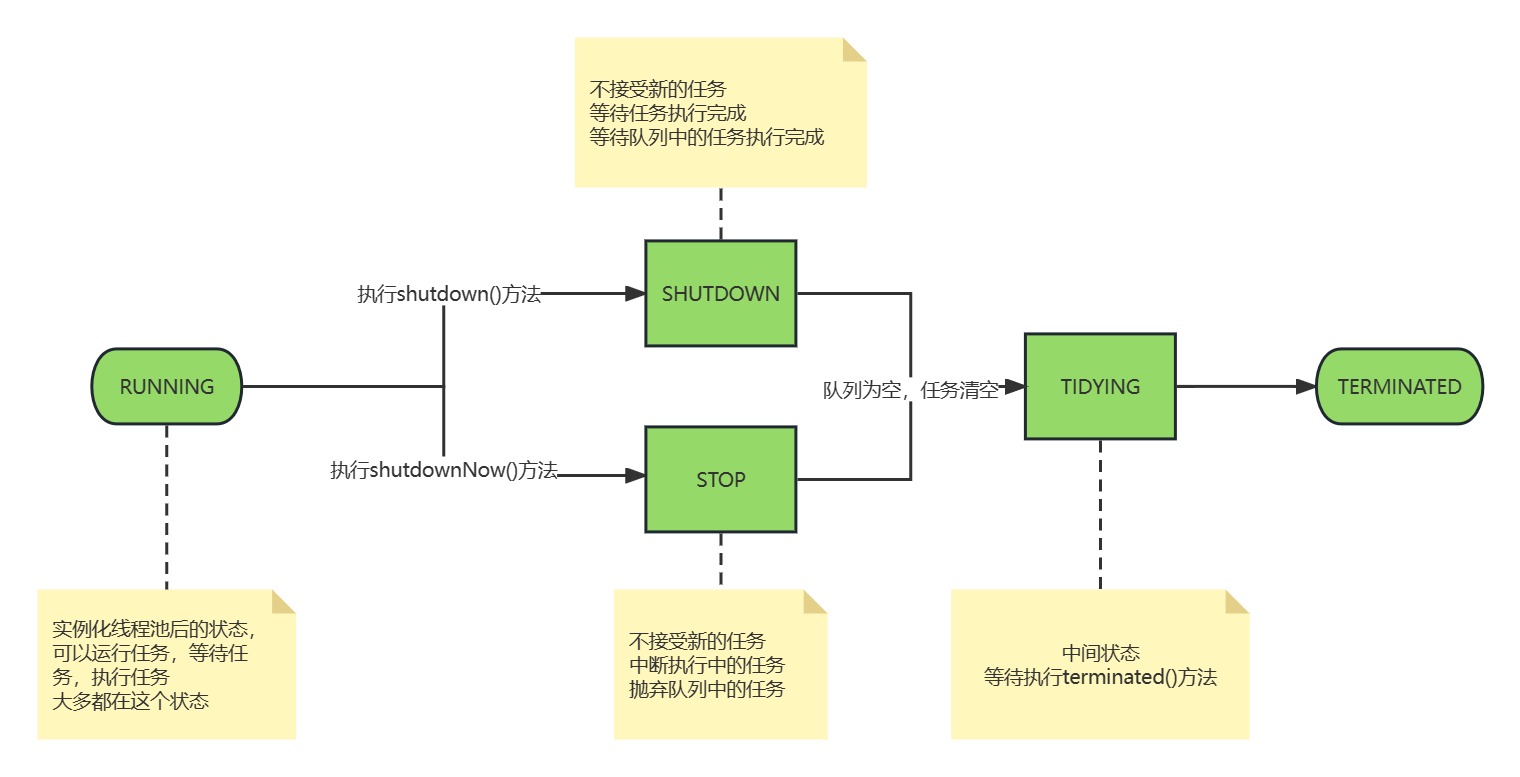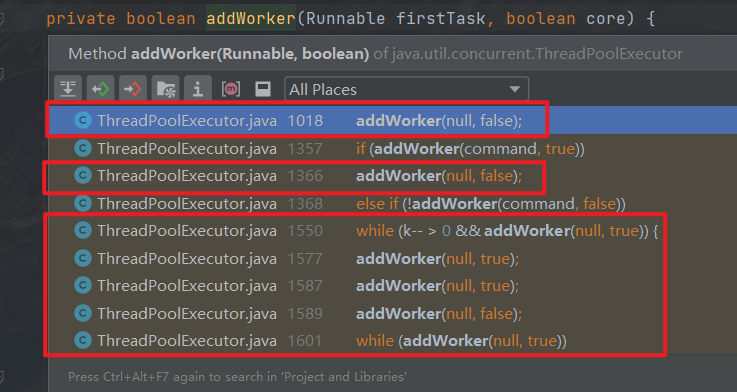Java中关于线程池的几道面试题
一、介绍
以前就讲过线程池的使用,本文中介绍深挖线程池中的几道面试题
Java线程池 | 半月无霜 (banmoon.top)
在上面可以找到
-
线程池的核心参数都有什么,代表什么含义?
-
线程池的拒绝策略有哪些?
二、线程池
1)任务添加流程
当一个线程池在添加一个任务时,它是怎么分配线程去执行这个任务的
1
2
3
4
5
6
7
8
9
10
11
12
13
14
15
16
17
18
19
20
21
22
23
24
25
26
27
28
29
30
31
32
33
34
35
36
37
38
39
40
41
42
43
| public class ThreadPoolExecutor extends AbstractExecutorService {
public void execute(Runnable command) {
if (command == null)
throw new NullPointerException();
int c = ctl.get();
if (workerCountOf(c) < corePoolSize) {
if (addWorker(command, true))
return;
c = ctl.get();
}
if (isRunning(c) && workQueue.offer(command)) {
int recheck = ctl.get();
if (!isRunning(recheck) && remove(command))
reject(command);
else if (workerCountOf(recheck) == 0)
addWorker(null, false);
}
else if (!addWorker(command, false))
reject(command);
}
private boolean addWorker(Runnable firstTask, boolean core) {
}
}
|

2)线程池的状态有哪些
线程池的状态有哪些,状态是如何进行转换的?
注意是在提问线程池的状态,而不是线程的状态
这是ThreadPoolExecutor.java中的源码
1
2
3
4
5
6
7
8
9
10
11
12
13
14
15
16
17
18
19
20
21
22
23
24
25
26
27
28
29
30
31
32
33
34
35
36
37
38
39
40
41
42
43
44
45
46
47
|
private final AtomicInteger ctl = new AtomicInteger(ctlOf(RUNNING, 0));
private static final int COUNT_BITS = Integer.SIZE - 3;
private static final int CAPACITY = (1 << COUNT_BITS) - 1;
private static final int RUNNING = -1 << COUNT_BITS;
private static final int SHUTDOWN = 0 << COUNT_BITS;
private static final int STOP = 1 << COUNT_BITS;
private static final int TIDYING = 2 << COUNT_BITS;
private static final int TERMINATED = 3 << COUNT_BITS;
private static int runStateOf(int c) {
return c & ~CAPACITY;
}
private static int workerCountOf(int c) {
return c & CAPACITY;
}
private static int ctlOf(int rs, int wc) {
return rs | wc;
}
|
由上面源码可知,线程的状态一共有5个
-
RUNNING:运行状态,线程池正在接受、处理任务
-
SHUTDOWN:当RUNNING状态调用shutdown()方法时,进入此状态;
- 不再接受新的任务
- 正在运行中的任务和队列中的任务会等待其执行完毕
-
STOP:当RUNNING或SHUTDOWN调用shutdownNow()方法时,进入此状态
- 不再接受新的任务
- 中断运行中的任务,销毁队列中的任务
-
TIDYING:由SHUTDOWN或STOP状态进入,所有线程结束完毕,等待调用terminated()方法
-
TERMINATED:由TIDYING状态进入,terminated()方法执行完毕
如果是画图的话,是下面这个样子的

terminated()方法默认什么都不做,线程池提供这个方法,交给子类来进行扩展
1
| protected void terminated() { }
|
3)线程池如何去执行任务的
添加任务的流程我们已经讲述完毕,那么线程池是如何分配线程去执行任务的呢?
在第一节中,有一段...的addWorker()方法,这里面就是执行任务的逻辑
1
2
3
4
5
6
7
8
9
10
11
12
13
14
15
16
17
18
19
20
21
22
23
24
25
26
27
28
29
30
31
32
33
34
35
36
37
38
39
40
41
42
43
44
45
46
47
48
49
50
51
52
53
54
55
56
57
58
59
60
61
62
63
64
65
66
67
68
69
70
71
72
73
74
75
76
77
78
79
80
81
82
83
84
85
86
87
88
89
90
91
92
93
| private boolean addWorker(Runnable firstTask, boolean core) {
retry:
for (;;) {
int c = ctl.get();
int rs = runStateOf(c);
if (rs >= SHUTDOWN &&
!(rs == SHUTDOWN && firstTask == null && !workQueue.isEmpty()))
return false;
for (;;) {
int wc = workerCountOf(c);
if (wc >= CAPACITY ||
wc >= (core ? corePoolSize : maximumPoolSize))
return false;
if (compareAndIncrementWorkerCount(c))
break retry;
c = ctl.get();
if (runStateOf(c) != rs)
continue retry;
}
}
boolean workerStarted = false;
boolean workerAdded = false;
Worker w = null;
try {
w = new Worker(firstTask);
final Thread t = w.thread;
if (t != null) {
final ReentrantLock mainLock = this.mainLock;
mainLock.lock();
try {
int rs = runStateOf(ctl.get());
if (rs < SHUTDOWN ||
(rs == SHUTDOWN && firstTask == null)) {
if (t.isAlive())
throw new IllegalThreadStateException();
workers.add(w);
int s = workers.size();
if (s > largestPoolSize)
largestPoolSize = s;
workerAdded = true;
}
} finally {
mainLock.unlock();
}
if (workerAdded) {
t.start();
workerStarted = true;
}
}
} finally {
if (! workerStarted)
addWorkerFailed(w);
}
return workerStarted;
}
|
4)为什么线程池中会把null作为任务添加
看下图,很多调用addWorker()方法都传递了一个null,这是为什么呢,有什么用?

首先说结论,这是为了更快的启动队列中的任务。
大家通过上面第一节的任务添加流程就会发现,有一些任务在添加进入任务阻塞队列后就没有声音了。
那么就要看看,如果添加一个为null的任务会出现什么情况把。
1
2
3
4
5
6
7
8
9
10
11
12
13
14
15
16
17
18
19
20
21
22
23
24
25
26
27
28
29
30
31
32
33
34
35
36
37
38
39
40
41
42
43
44
45
46
47
48
49
50
51
52
53
54
55
56
57
58
59
60
61
62
63
64
65
66
67
68
69
70
71
72
73
74
75
76
77
78
79
80
81
82
83
84
85
86
87
88
89
90
91
92
93
94
95
96
97
98
99
100
101
102
103
104
105
106
107
108
109
110
111
112
113
114
115
116
117
118
119
120
121
122
123
124
125
126
127
128
129
|
private boolean addWorker(Runnable firstTask, boolean core) {
if (workerAdded) {
t.start();
workerStarted = true;
}
}
private final class Worker extends AbstractQueuedSynchronizer implements Runnable {
Worker(Runnable firstTask) {
setState(-1);
this.firstTask = firstTask;
this.thread = getThreadFactory().newThread(this);
}
public void run() {
runWorker(this);
}
final void runWorker(Worker w) {
Thread wt = Thread.currentThread();
Runnable task = w.firstTask;
w.firstTask = null;
w.unlock();
boolean completedAbruptly = true;
try {
while (task != null || (task = getTask()) != null) {
w.lock();
if ((runStateAtLeast(ctl.get(), STOP) ||
(Thread.interrupted() &&
runStateAtLeast(ctl.get(), STOP))) &&
!wt.isInterrupted())
wt.interrupt();
try {
beforeExecute(wt, task);
Throwable thrown = null;
try {
task.run();
} catch (RuntimeException x) {
thrown = x; throw x;
} catch (Error x) {
thrown = x; throw x;
} catch (Throwable x) {
thrown = x; throw new Error(x);
} finally {
afterExecute(task, thrown);
}
} finally {
task = null;
w.completedTasks++;
w.unlock();
}
}
completedAbruptly = false;
} finally {
processWorkerExit(w, completedAbruptly);
}
}
private Runnable getTask() {
boolean timedOut = false;
for (;;) {
int c = ctl.get();
int rs = runStateOf(c);
if (rs >= SHUTDOWN && (rs >= STOP || workQueue.isEmpty())) {
decrementWorkerCount();
return null;
}
int wc = workerCountOf(c);
boolean timed = allowCoreThreadTimeOut || wc > corePoolSize;
if ((wc > maximumPoolSize || (timed && timedOut)) && (wc > 1 || workQueue.isEmpty())) {
if (compareAndDecrementWorkerCount(c))
return null;
continue;
}
try {
Runnable r = timed ?
workQueue.poll(keepAliveTime, TimeUnit.NANOSECONDS) :
workQueue.take();
if (r != null)
return r;
timedOut = true;
} catch (InterruptedException retry) {
timedOut = false;
}
}
}
}
|
三、最后
当前线程池的解读就到这里了,如果不是为了造火箭,谁会看这么底层的东西。
有一说一,这线程池写起来真的很优雅!!!
我是半月,你我一同共勉!














